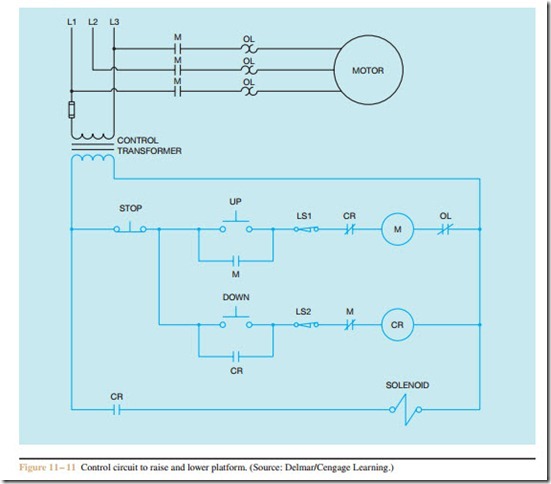Subminiature Micro Switches
The subminiature micro switch employs a similar spring contact arrangement as the basic micro switch (Figure 11 – 8). The subminiature switches are approximately one-half to one-quarter the size of the basic switch, depending on the model. Due to their reduced size, the contact ratings of subminiature switches range from about 1 ampere to about 7 amperes depending on the switch type. A different type of subminiature micro switch is shown in Figure 11 – 9.
Limit Switch Application
Figure 11–10 illustrates a common use for limit switches. A platform is used to raise material from a bottom floor to an upper floor. A hydraulic cylinder is used to raise the platform. A limit switch located on the
bottom floor detects when the platform is in that position, and a second limit switch on the upper floor detects when the platform has reached the upper floor. A hydraulic pump is used to raise the platform. When the platform is to travel from the upper floor to the lower floor, a solenoid valve opens and permits oil to return to a holding tank. It is not necessary to use the pump to lower the platform because the weight of the platform will return it to the lower floor.
The schematic diagram for this control circuit is shown in Figure 11–11. The schematic shows both limit switches to be normally closed. When the plat- form is at the extent of travel in either direction, however, one of the limit switches will be open. If the platform is at the bottom floor, limit switch LS2 will be open. If the UP push button is pressed, a circuit will be completed to M starter, causing the motor to start raising the platform. The M normally closed contact will open to prevent CR from being energized at the same time. When the platform begins to rise, limit switch LS2 will close. The platform will continue up- ward until it reaches the top, causing limit switch LS1 to open. This will de-energize M contactor, causing the motor to stop and the normally closed auxiliary contact in series with CR coil to re-close.
When the DOWN push button is pressed, control relay CR will energize. The normally closed CR contacts connected in series with M contactor will open to
interlock the circuit, and the normally open CR contact connected in series with the solenoid coil will close. When the solenoid coil energizes, the platform will start downward, causing limit switch LS1 to re-close. When the platform reaches the bottom floor, limit switch LS2 will open and de-energize coil CR.
Review Questions
1. What is the primary use of a limit switch?
2. Why are the contacts of a micro switch spring loaded?
3. Refer to the circuit shown in Figure 11–11.
Assume that the platform is located on the
bottom floor. When the UP push button is pressed, the pump motor does not start. Which of the following could not cause this problem?
a. The contacts of limit switch LS1 are closed.
b. The contacts of limit switch LS2 are open.
c. Motor starter coil M is open.
d. The overload contact is open.
4. Refer to the circuit shown in Figure 11–11.
Assume that the platform is located on the lower floor. When the UP pushbutton is pressed, the platform raises. When the platform reaches the upper floor, however, the pump does not turn off but continues to run until the overload relay opens the overload contacts. Which of the following could cause this problem?
a. The solenoid valve opened when limit switch LS1 opened.
b. The UP pushbutton is shorted.
c. Limit switch LS1 did not open its contacts.
d. Limit switch LS2 contacts did not re-close when the platform began to rise.
5. Refer to the circuit shown in Figure 11–11.
Assume that the platform is located at the upper floor. When the DOWN push button is pressed, the platform does not begin to lower. Which of the following could not cause the problem?
a. Control relay coil CR is open.
b. Limit switch LS1 contacts are open.
c. Limit switch LS2 contacts are open.
d. The solenoid coil is open.

